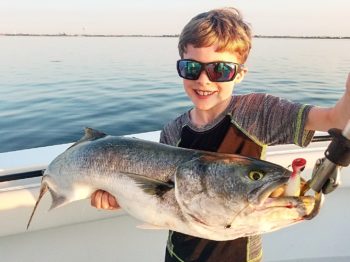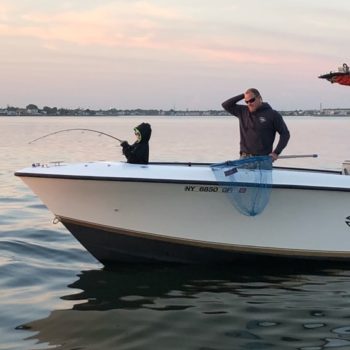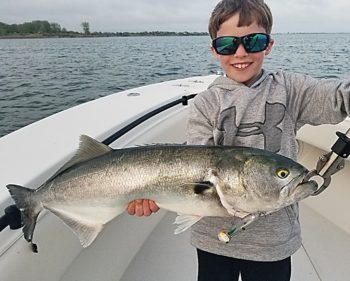
Release Mortality Revisited: New Research from Massachusetts DMF
Feature Photo Credit: Robbie Tartaglia What’s going on? For decades, striped bass management relied on a
Originally Published Here on Conservefish.org

Oliver with bluefish
BY JOHN McMURRAY
While it’s probably not great for business for me to admit it, I’ve gotta be honest, on the striped bass front, it’s been tough going this spring.
Lots of small fish around, but those 30-plus inch fish, (I’m talking specifically about the 2011’s – the only good year class since 2003) are sparse.
Yes, we’ve had some good days and better fish here and there – I’ve done well over 50 trips thus far – but Jamaica Bay has been, ahem, difficult. Sure, I’m just talking about my little neck of the woods, and there’ve been more consistent, albeit short-lived, bites elsewhere, but overall, this spring has been what most consider to be below average.
Why that’s the case, well, we can talk about how we’ve been hammering on the 2011s for a few years now, and we can talk about a declining striped bass population in general, and how managers are trying to lower the bar on what we consider a “healthy” stock. And sure, we can talk about how menhaden (aka bunker) aggregations are a shadow of what they were in prior years, and that maybe that has something to do with the increase in menhaden harvest we’ve allowed. But that’s all fodder for an entirely separate blog post.
The point is that the striped bass fishing hasn’t been great for me.
Because I more-or-less built my life around this stuff, as the season materialized I quickly became a pretty miserable person to be around.
Until, one day I looked at my phone and there was a text from my neighbor: “some pretty cool stuff going on close to home.” With little hesitation, I grabbed my 9-year-old boy from the couch and we were underway. Within minutes, I knew what he was talking about.
As the sun began to dip over glass like conditions, there were tails – lots of them – almost as far as the eye could see. Big freak’n bluefish cruising, daisy-chaining, and tailing in two-to-three-feet of water.
It took only one precision cast from my boy (he’s got mad skills for a kid) before the water exploded.

Bluefish are biting
That high-pitched voice he has when he screams “WHOA!” is priceless… and, it is profound. Because that’s my DNA right there. I don’t think there’s ANYTHING that can make me more stoked.
In the space of minutes, my entire disposition, my entire view on life had changed from crappy to awesome.
For the next two hours there was a lot of hooting and hollering as we threw topwater plugs at these tailing fish and witnessed some of the most extraordinarily violent surface strikes I’d ever seen. Thirty-five inch bluefish were airing out to get on the plugs. We ended that day with a solid 18lb-er (on the BogaGrip), and while we caught a lot, we didn’t kill one of them.
While the numbers of fish up on that flat ebbed and flowed, I stayed on this bite, putting flyfishers, spin fishers, and of course my kids, on those fish for a solid three weeks. Even had a film crew out and got some sick drone footage, so stay tuned for that.
It was pretty awesome fishing. It saved my spring. And, well, it may have saved me.
Seriously, thank God for bluefish!
And guess what? Out of all those trips, and all those clients, we took home only two fish the entire span of that bite. The rest of them, likely well over 100, went back in the water, so we and perhaps other anglers could catch them again.
And that’s a good segue into what I really want to get at here.

Oliver with bluefish
The Mid-Atlantic Fishery Management Council (Council) and the Atlantic States Marine Fisheries Commission (Commission) jointly manage bluefish.
How exactly they manage it is unique.
Currently anglers get about 80% of the fish and the commercial sector gets about 20%. That’s all well and good, but when anglers don’t catch and kill their entire quota – and most of the time we don’t, because, as we all know, bluefish has evolved into mostly a release fishery – those uncaught fish get transferred over to the commercial side.
This is and always has been problematic for a number of reasons. For one, it’s an administrative burden for staff. But more importantly, it just kinda sucks for anglers because, well, we’re releasing those fish only so that, theoretically, they can be turned over to the commercial sector to kill.
In that context, the motivation to practice “conservation” with bluefish – releasing them because they are more valuable to us in the water than dead – disappears. Many perceive such a situation to be quite unfair.
Because there’s been quite a bit of concern over the allocation of the bluefish resource, the Council and the Commission have embarked on a “comprehensive review of the Bluefish Fishery Management Plan’s (FMP) sector-based allocations, commercial allocations to the states, transfer processes, and goals and objectives.” Currently we are in the “scoping” phase of a Bluefish Allocation Amendment.
The purpose of such scoping is to gather information from the public on what the issues are and what issues the amendment should address. It is “step one” in the amendment process.
Public hearings have been scheduled from June 20 to July 16 (you can find a full listing below as well as instructions on how to submit written comments which will be accepted until July 30th).
So, it sounds like maybe there’s an opportunity to get all of this sorted out… Or maybe not.
If the scoping hearings occur, and there is no significant input from the angling community, well, managers will decide that anglers just don’t care about bluefish and that there is no problem reallocating fish released by anglers to the commercial side, to make sure the whole quota is killed. If that happens, the current 80/20 split may end up getting reversed, with the commercial sector getting the lion’s share. That would be bad.
Anglers are likely the most important stakeholders in this fishery. Bluefish are often really important to me – to us! They save seasons! And the recreational fishery, including the catch and release fishery, carries with it a significant economic component as far as tackle and fuel bought, trips taken, etc. On the other hand, bluefish are a relatively low-value commercial species, selling for less than 20% of the price commanded by more popular species such as striped bass, black sea bass and summer flounder. Managers need to know and understand that the greatest economic value comes from those fish left swimming in the water, rather than from those piled dead on the dock.
That being the case, most of our quota can and should be used to maintain, perhaps even increase bluefish abundance, to support the great majority anglers who choose to release their catch.
The recreational quota shouldn’t simply be based on the fish that anglers extract, because such an approach does not reflect the realities of the recreational bluefish fishery. Anyone with even a remote understanding of the recreational bluefish fishery should get that.
Still, managers are accustomed to managing for extraction. The reality is that managing for fish in the water is something so foreign to managers that they aren’t likely to even consider this unless we weigh in during scoping, in good numbers. In fact, there wasn’t a mention of it in the scoping document until we flagged it.
We need to get ahead of this one to make sure we get heard. I’m going to provide comprehensive info below on how to comment, but before we get to that, I want to explain why this is bigger than just bluefish.
Managers should understand and seriously consider the value of fish left in the water in general, instead of simply developing regulations that allow special interests to extract the max amount possible. Not just for bluefish, but for every recreationally important fishery. While bluefish is drawing a pretty good example here right now, there are lots of others. King mackerel anglers went through a similar reallocation process a few years ago, for just the same reasons. Striped bass could also fall victim to the same mindset, but arguably it applies to any fish that anglers pursue primarily for sport, rather than food.
That would be a serious threat to the recreational fishery because, to be successful, anglers need fish in the water – a lot of fish. We use the least efficient gear, and so we need abundance. Just having an abundance of fish in the water to catch is far more important than smaller size limits and larger bag limits or how many fish we can kill. NOAA surveys have indicated as much.
Thus, the fact that anglers value “experience” above mere extraction should be acknowledged, emphasized and better accounted for when developing management measures. And that is what anglers should be pushing for.
But, as a group, we aren’t. At least some of us aren’t. While conservation and leaving-fish-in-the-water certainly used to be a priority to the angling community, without a doubt, some organizations purporting to represent us have shifted focus towards extraction, and that’s unfortunate.
Such organizations have it right that the current system caters to the commercial side. Bluefish is a case in point. But where they don’t have it right is their insistence that they need to be able to kill more fish in order to make the recreational fishing industry (tackle and boat manufacturers, etc.) more viable, when emphasis should clearly be on the angler opportunity that comes from leaving more fish alive!
Why that shift from conservation to extraction? Well, it’s beyond me.
I’ve heard all the reasons, but they make little sense. Despite how it’s being spun, both the Modern Fish Act and the Strengthening Fishing Communities and Increasing Flexibility in Fisheries Management Act are about easing conservation and management language in the Magnuson-Stevens Act, to allow higher harvests and delay stock rebuilding. There is no provision that I’m aware of in either of those two bills that seeks to keep more fish in the water.
Aggressively trying to weaken federal fishery management law through “flexibility” – loopholes that allow overfishing – while claiming it would improve access to fish is bad policy. Loopholes = overfishing = less fish in the water; commercial fishermen gain access, anglers lose it. With less precautionary management and greater flexibility to allow overfishing, we’re likely screwed.
And speaking of bluefish, this is a ripe issue for those organizations to become engaged in, perhaps expressing to managers how important keeping these fish in the water is to their constituents. I’m not holding my breath, though.
Bluefish are damn important to the angling community.
I’m not talking about dead bluefish, I’m talking about the live ones, swimming around in the water right now. The ones that tail in two or three feet of water. The ones that make my son scream like a crazy person when a big’un smashes his topwater plug (much like his Dad does).
Keeping a lot of those fish swimming around in the water for the economically important recreational sector should be a priority for managers. We need to weigh in so they understand that.
But in a larger context the entire idea of keeping fish in the water, for the encounters and the recreational experience, should be returned to the forefront of recreational advocacy, way ahead of pushing for laws that seek merely to increase the kill.
But that’s a long-term goal. For now, let’s focus on bluefish.
Please show up at one of the meetings below to talk about the importance of leaving a few bluefish in the water. And if you can’t? Please submit written comments by July 30, 2018.
Written comments may be sent by any of the following methods:
Here’s what to say:
It’s pretty simple.
And that’s about it.
Do it now…
And thanks for reading.

Feature Photo Credit: Robbie Tartaglia What’s going on? For decades, striped bass management relied on a

Recent developments in the 2025 Atlantic Menhaden Stock Assessment Update, released by the Atlantic States

What’s going on? The “most important fish in the sea” just exposed one of the

Mario CampoFisheries Ecologist, Southeastern Louisiana UniversityScience and Policy Associate, American Saltwater Guides Association This discussion
We rely on our members and donations to keep fighting for a sustainable tomorrow in marine conservation.
GIVE THE GIFT OF FISHERIES CONSERVATION THIS HOLIDAY SEASON. SHOP ASGA GOODS THAT FUND FISHERIES RESEARCH & ADVOCACY CAMPAIGNS
JOIN ASGA IN CALLING FOR CRITICAL MANAGEMENT ACTION AFTER YEARS OF SPAWN FAILURES & POOR MANAGEMENT.
By using this website, you agree to our use of cookies. We use cookies to provide you with a great experience and to help our website run effectively. To learn more, please review our privacy policy.